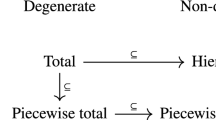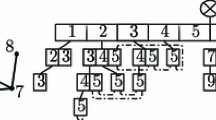Abstract
An indecomposable shape is like a prime number. It cannot be decomposed further as a Minkowski sum of two simpler shapes. With respect to Minkowski addition (dilation), therefore, the indecomposable shapes are the fundamental building blocks of all geometric shapes. However, just as it is difficult to identify whether a given number is a prime number or not, it is equally or more difficult to say whether a given shape is indecomposable or not. In this paper we take up a subdomain of binary images, called the weakly taxicab convex image domain, and show how the indecomposability problem in that shape domain can be approached in a manner closely analogous to the number theoretic way. Apart from our attempt to show that the indecomposability problem is an extremely interesting mathematical problem, our algorithmic treatment of the problem also leads to an efficient method of computing Minkowski addition and decomposition of binary images.
Similar content being viewed by others
References
L. Danzer, B. Grunbaum, and V. Klee, “Helly's theorem and its relatives,” Convexity—Proceedings of the Symposium in Pure Mathematics, Am. Math. Soc., Providence, Rhode Island, 1963, Vol. VII, pp. 101–180.
P.K. Ghosh, “An algebra of polygons through the notion of negative shapes,” CVGIP: Image Understanding, Vol. 54, No. 1, pp. 119–144, 1991.
P.K. Ghosh and R.M. Haralick, Indecomposability Problem in Mathematical Morphology, SPIE Proceedings on Vision Geometry, 1992, Vol. 1832, pp. 122–131.
P.K. Ghosh and R.M. Haralick, “Mathematical morphological operations of boundary-represented geometric objects,” Journal of mathematical Imaging and Vision, Vol. 6, Nos. 2/3, 1996.
R.M. Haralick, S.R. Sternberg, and X. Zhuang, “Image analysis using mathematical morphology,” IEEE Trans, on PAMI, Vol. PAMI-9, No. 4, pp. 532–550, 1987.
Henk J.A.M. Heijman, Morphological Image Operators, Academic Press, 1994.
K. Iwano and K. Steiglitz, “Testing for cycles in infinite graphs with periodic structure,” in Proc. of ACM Sympos. on Theory of Computing, 1987, pp. 46–55.
M. Kallay, “Indecomposable polytopes,” Israel. J. Math., Vol. 41, pp. 235–243, 1982.
M. Kallay, “Decomposability of polytopes is a projective invariant,” Annals of Discrete Math., Vol. 20, pp. 191–196, 1984.
T. Kanungo and R.M. Haralick, “Vector-space solution for a morphological shape-decomposition problem,” Journal of Mathematical Imaging and Vision, Vol. 2, pp. 51–82, 1992.
C.E. Kim and A. Rosenfeld, “Digital straight lines and convexity of digital regions,” IEEE Trans. on PAMI, Vol. PAMI-4, No. 2, pp. 149–153, 1982.
E.F. Krause, Taxicab Geometry, Dover Publications, 1986.
P. McMullen, “Representations of polytopes and polyhedral sets,” Geom. Dedicata, Vol. 2, pp. 83–94, 1973.
W. Meyer, “Indecomposable polytopes,” Trans. of the American Math. Society, Vol. 190, pp. 77–86, 1974.
R.A. Melter, “A survey of digital metrics,” Contemporary Mathematics, Am. Math. Soc., Vol. 119, pp. 95–106, 1991.
R.S. Millman and G.D. Parker, Geometry: A Metric Approach with Models, Springer-Verlag, 1982.
D. Mount and R. Silverman, “Combinatorial and computational aspects of Minkowski decompositions,” Contemporary Mathematics, Am. Math. Soc., Vol. 119, pp. 108–124, 1991.
F.P. Preparata and M.I. Shamos, Computational Geometry: An Introduction, Springer-Verlag, 1985.
J. Serra, Image Analysis and Mathematical Morphology, Academic Press, 1982.
G.C. Shephard, “Decomposable convex polyhedra,” Mathematika, Vol. 10, pp. 89–95, 1963.
Z. Smilansky, “Decomposability of polytopes and polyhedra,” Geom. Dedicata, Vol. 24, pp. 29–49, 1987.
J. Xu, “Decomposition of convex polygonal morphological structuring elements into neighborhood subsets,” IEEE Trans. on PAMI, Vol. 13, No. 2, pp. 153–161, 1991.
Author information
Authors and Affiliations
Rights and permissions
About this article
Cite this article
Ghosh, P.K. The indecomposability problem in binary morphology: An algorithmic approach. J Math Imaging Vis 6, 169–198 (1996). https://doi.org/10.1007/BF00119838
Issue Date:
DOI: https://doi.org/10.1007/BF00119838




